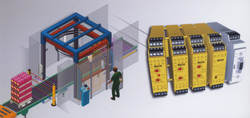
Posted to News on 6th Oct 2006, 22:10
Sick's UE 410 Flexi modular safety controller needs no software
Five years ago, relays were the only practical option for safety controls on machines, but recent technical advances have seen the development of numerous software-based controllers that also solve safety-related control issues. Indeed, these developments saw many industrial automation experts predicting the demise of relays. Despite these predictions, relays still occupy an astounding 80 per cent market share; the basic fact remains that relays are a scalable way to implement almost all industrial safety-related control systems.

However, many safety relay applications require customers to undertake hours of tedious wiring in order to implement the particular safety logic needed for their application. Customers often endure these wiring challenges rather than using proprietary firmware-based safety-rated controllers that require software for configuration and may not support the necessary scalability of the application.
Sick has overcome the problems of complex wiring and the need for proprietary software with its new UE 410 Flexi Modular Safety Controller, a series of modular units that allows users to implement complex safety-rated logic without the use of software. The logic functionality within the UE410 Flexi series is easily implemented by using simple rotary switches on the front of each module.
Minimum modules, maximum functions
The UE410 Flexi series comprises a number of units - a main control unit, an expansion (extension) control unit, an eight dual-channel safety input module, a one-dual-channel safety relay output module (two normally-open and one normally-closed contact), a two-dual-channel safety relay output module (four normally-open and two normally-closed contacts), a DeviceNet interface module and a Profibus interface module.
Modules can be combined with one another to create a bespoke safety logic system specific to the user's application, using the interface connections on the side of each unit. A combination of up to 104 inputs and outputs can be supported, while the fieldbus network communication modules can be used to provide diagnostic information for the plant-wide system.
Until now, users have needed different safety relays for different safety systems such as: two-hand control applications; contact-based safety outputs such as safety interlock switches; semiconductor-based safety outputs from light curtains or laser scanners; and emergency stop applications. Addressing this complexity overhead, the UE410-Flexi can handle all of these devices and, using the modules, combine them logically, thanks to eight possible settings on each module.
Save space on the panel
Another benefit the UE410-Flexi offers is that the number of different relays needed for a particular application is drastically reduced - saving on spares and panel space. Devices that can connect to the UE410-Flexi include: emergency stop pushbuttons, Type I1IA and IIIC two-hand controls, safety interlock switches, non-contact switches, testable Type 2 sensors, hold-to-run (enable) switches, safety light curtains and safety light grids, safety laser scanners and muting sensors for two-input muting.
To assist users with selecting the correct settings for the switches on the modules, Sick has developed a software tool that can be downloaded for free from its website. For each switch setting, the tool shows what the module's functions are, enabling a schematic of the safety circuit to be compiled - including the safety devices on the machine.
For more complex machinery, expansion units can be used to create separate safety zones so that, for example, breaching a light curtain on a palletiser at one end of the machine will not halt the infeed conveyor at the far end.
And if you think this all sounds expensive, bear in mind that the master module costs approximately the same as a traditional two-channel relay for use with a safety light curtain.
Some facts
Safety categories: The system is designed to meet the requirements of safety circuits for Category 2, 3 or 4 machines as described in BS EN 954-1 or SIL 1, 2 or 3 of BS EN (IEC) 61508 or BS EN (IEC) 62061.
50 per cent reduction of cabinet space: The UE410-MU handles the function of two safety relays in a single 22.5mm housing and, by supporting eight inputs, it can replace an additional four safety relays.
Simple commissioning and no software: The safety logic of most machines is generally less complicated than the standard control of the machine. Using program switches on the front of the modules, users can implement AND, OR, Bypass and Muting functionality without the use of software tools.
Wiring savings: The logic blocks are accessed by selecting pre-configured functions using the program switches, therefore the typical wiring used to achieve this logic disappears. For example: the UE410-8 dual-channel safety input module can take four dual channel inputs and combine them with the inputs on a UE410-Flexi main control unit using AND, OR, or Bypass logic. All that is required is connection of the monitored devices and setting the program switches. To implement a similar logic scheme using safety relays, ten or more relays would be necessary.
Relay expansion: Once this logic has been implemented, semiconductor outputs located on the main control unit can be used to switch off the dangerous motion. Easy implementation of relay outputs can be achieve using the one and two dual-channel Safety Relay Output Module
Diagnostics and fieldbus: For diagnostic information, each module has LEDs that indicate the state of the associated inputs and outputs as well as fault conditions and reset requirements. Additionally, the DeviceNet and the Profibus modules can be used to deliver a wide range of status and diagnosis information.
A real-world example
An example of the advantages the UE410-Flexi offers can be seen at Haloila Oy in Finland - a leading manufacturer of thin-film wrapping machines. Haloila's machines have a reputation for their speed and flexibility in the industry, using two parallel plastic foil rolls to wrap pallets, which, in turn, protects and stabilises the palletised goods.
In order to satisfy the requirements of Haloila's safety application, six safety relays were previously needed, consuming 225mm of DIN rail space in the control panel. Each of the relays was wired to one another in order to achieve the logic needed in the application.
Four relays were used to integrate two M4000 entry exit systems. These relays were then logically 'ANDed' with an emergency stop circuit safety relay (safety relay 5) and another safety relay that monitored a safety door interlock at a gate where the foil was reloaded (safety relay 6). The logic required for this installation required significant extra wiring - a level not needed using the Flexi system. With the UE410-Flexi, just two units are used to integrate all six sensors, reducing the total DIN rail requirement from 225mm to 45mm. If an additional interlock or emergency stop switch is added, this is done through simply adding an additional Flexi module.
Want the latest machine building news straight to your inbox? Become a MachineBuilding member for free today >>















